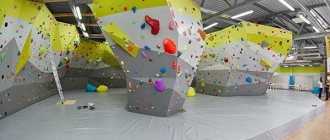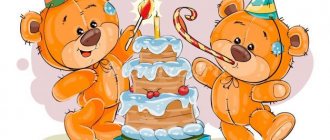Who will give more answers
Parents participate, helped by know-it-all children. The presenter asks questions, for example, name the cartoons in which there is a character - Bear? And each of the guests, in turn, with the child’s prompt, names one cartoon (Masha and the Bear, Umka, Bag of Apples, etc.), whoever stumbles is eliminated from the circle. Then the second question is asked, for example, name a cartoon where there is winter? (Winter in Prostokvashino, Snowman-postman, and so on). We play like this until out of the remaining pair of finalists there is only one winner left with his little hint.
Find something tasty
The presenter should prepare in advance special boxes in boxes, and those in boxes, in general, according to the principle of cabbage. And in the very last box or bag there is a tasty treat hidden, depending on the age of the children, it could be candy or an apple. Little guests are seated comfortably and given boxes, explaining what they need to find yum-yum in the box. It will be interesting for guests to watch how kids rummage through bright and colorful bags or boxes, opening one after another, in search of tasty treats.
Dressing up is one of children's favorite games
With the help of this game, a child can feel like a real “adult” and at the same time rummage through their parents’ wardrobe. He puts on daddy's (or mommy's) coat and can sit on daddy's (or mommy's) shoulders. The coat is fastened with buttons, except those at adult eye level. Perhaps your child would like to wear a matching hat? Now the “giant” reveals himself to the rest of the family - this is the greeting. Of course, the giant can also speak, but in a deep and perhaps somewhat mysterious voice. You can ask your child if he wants to speak for himself or if this should be done by the adult on whose shoulders the baby is sitting.
Grab the tape!
There must be three or more players for this game. Everyone receives a wide colored ribbon (alternatively a scarf or handkerchief) which they put in their pocket, belt loop or simply in the waistband of their skirt or trousers so that it hangs down without dragging on the floor. Now you need a little free space, for example, in the hallway, or you can at least move the furniture to the side in a more spacious room. Now all players try to steal ribbons from others without losing their own. Anyone who loses the ribbon is eliminated. The one who has the most ribbons from other people, but still has his own, wins.
Advice when playing: if there are few players, it is better to declare the winner the one who kept his ribbon to himself the longest.
Games for children 4 years old
Game 13. “I don’t see and I don’t hear”
This is a great outdoor game for two or more players that children really enjoy. Rules: when the presenter says “I don’t see,” the players run, jump, frolic, but in absolute silence. If someone makes a sound, they lose. If the presenter says “I don’t hear,” then the players can and should make noise, shout, sing, laugh, but stand in one place. Whoever moved lost.
The game is more suitable for the street, so that children can run around and shout to their heart's content without disturbing the neighbors.
Game 14. “Colored paints”
This is a great game for reinforcing knowledge of colors and their shades. It requires a minimum of three participants.
We are sure many parents will remember the rules! You need to draw a line (or lay a rope or cord), on one side of which the leader stands, and on the other, the players. The presenter turns his back, names any color and turns back. Whoever has this color on their clothes easily crosses to the other side, but the rest of the participants must run across before the leader grabs them. Which player he caught takes the place of the leader.
Game 15. “Obstacle Course”
This game will require a little preparation, as you need to create “difficulties” that the children will overcome. It is best to play in a group or even in teams for speed.
Focusing on the interests of the baby, create an obstacle course (chairs to crawl under, a tunnel of pillows, leaves that will save you from a lava river, and so on). The theme can be different, for example, hunting dinosaurs, rescuing a princess from a dragon, a jungle, a pirate island and any other fantasy.
If teams are playing, you can prepare a main prize for the winners and an incentive prize for the losers. But the most important reward in the “Obstacle Course” will be a great mood and a boost of energy!
Game 16. “Again and Again”
An excellent game that develops classification and analysis skills.
You will need cards with pictures of animals, plants, furniture, flowers, transport and anything else that can be classified.
The essence of the game is to lay out all the pictures in front of the child, for example, with furniture and ask them to separate small objects from large ones, then wooden ones from plastic ones, and so on. The more options you have to analyze and compare, the better.
Game 17. “What’s in your mind?”
The purpose of the fun is to develop attention, auditory perception, and speech in a fun and interesting way.
Prepare several simple pictures with different contents and ask your child to choose one, but do not say which one. Then the adult asks questions to figure out which image was chosen, and the child answers either yes or no. For example: “There is a person in this picture?”, “Is there yellow in the person’s clothes?” Then switch roles - who will complete the task faster?
Ready-made plot pictures or images of animals can be purchased at any bookstore or made yourself by cutting them out of magazines.
Game 18. “Mysterious actions”
Two or more people play and need to understand what the presenter is showing with his gestures or actions. For example, an adult pinches his nose, closes his eyes and squats - this is diving into the water. You can wish for any real objects or activities: writing, swimming, sleeping, hammering, and so on. The presenter can prepare possible options in advance and write them down on cards. The participant who named the correct answers faster than the others wins.
Game 19. “Who can do that?”
Another interesting game for speech development. The task is simple - to guess what is being said faster than other players. The presenter describes an object, person or character, for example: “This is a small metal object that makes a thin sound. Such small objects are often hung around the neck of pets” (bell).
The game helps to consolidate any acquired knowledge: about professions, transport, plants, animals, seasons and many other objects and phenomena.
Game 20. “Comparisons”
An adult shows the child two objects and asks them to tell what their similarities and differences are. For example: “Here is a ball and a balloon of different colors, compare them!” The similarity is that both objects are round in shape. Differences: color, material. The more signs the baby names, the better. Gradually make the task more difficult by selecting similar objects, for example, cubes of the same color, but slightly different in size. You can also increase the number of items being compared.
This game perfectly develops attention and improves classification and analysis skills.
Repeat the pattern
Identical pictures
Two identical objects
Game 21. “Questions and answers”
The essence of the game is to answer various questions asked by an adult. These can be either funny questions or educational and reinforcing ones. For example: “Are there thunderstorms in winter?”, “What color is the sun?” or “Why do you need to eat?”
The game develops speech and memory, as well as generalization skills and is suitable for quiet family evenings.
Game 22. “Teams”
An interesting, calm game for speech development. The presenter prepares funny commands in advance: “Sit down, those who love compote,” “Close one eye, those who drank juice today,” and so on. Fun is suitable for meeting new people because it allows you to get to know the interests of new friends and create a fun atmosphere.
Game 23. “Signals”
A very interesting game that develops attention and increases concentration, and also improves memory. The task is simple - the presenter prepares “signals” in advance (any cardboard figures of different colors) and shows them to the children. Each color denotes some action, for example, yellow - stand still, red - sit down, blue - raise your arms up. Show these signals to the players in random order. Gradually make the task more difficult and say commands by showing cards of a different color. The winner is the one who is not confused and follows the signals correctly.
Game 24. “Collecting toys”
An excellent active game that helps not only develop attention and memory, but also quickly clean the room! It is advisable that there are at least two participants in the game to make it a competition.
Take a few items and place them around the room in different places (or just verbalize what to look for). Children need to find all things as quickly as possible and put them in a drawer or basket. The one who comes first wins.
Then make the task more difficult and suggest continuing the search by standing on one leg, clapping, walking single file, or crawling.
What objects were in the picture?
Collect cobwebs
If necessary, the child can play this game alone or compete with one or more other players. For each child, you will need a packing cord 10 to 15 meters long, or a thick woolen thread (of course, in competitions, all cords or pieces of thread must be the same length!), which then needs to be stretched throughout the room. Each player tries to untangle their piece of the “web” as quickly as possible and roll it into a ball. The one who does it first will win.
The baby can play this game on his own: “Shovel”
It's possible to play this game alone, but it's more fun with a group. If there are several players, everyone takes off their shoes and puts them in a pile. If the child plays alone, you need to take out several pairs of shoes (important: clean!) from the shoe closet and put them in a pile. The baby should be blindfolded, and now he must again separate the shoes into pairs by touch. If he has difficulties, parents can give the child hints.
Parent and child - double talent
In this competition, every parent must show their ingenuity and resourcefulness. Pairs are formed: parent - child. Each couple chooses a forfeit that will indicate who they should show, for example, a pirate and a parrot. Then the parent becomes a pirate with appropriate facial expressions and gestures and places the child on his shoulder, who will act as a parrot. Or an example - Umka with a mother bear, a pot with a flower, where the pot will be the hug of the parent, and the flower will be the child. In general, with invented plots, everything depends on the imagination of the presenter, but how to show it is up to adults to think. Prizes for the most artistic couples.
Where did the toys go?
This game can be played alone or with one or more other players. Place 10 to 20 different toys (for example, stuffed animals, cars, dolls, dishes from a toy kitchen or store, ducks for the bath, perhaps also toys for the sandbox) on an empty table or free space on the floor. Ask all players to remember what is where. Then send all the kids out the door and move some items. All players are then allowed to go back and try to figure out which toy is currently in a different location. The one with the most accurate hits wins. This game trains your memory.
All games are useful for a child's development. They also allow adults to relax a little and spend quality time with their children.
leave a comment
Tigers in the jungle
This game must have three or more players. Redesign your living room a bit and turn it into a jungle by hanging blankets or towels on chairs, armchairs, tables and sofas so children can hide behind or under them. Now all players become animals and walk on all fours. One of them is a tiger that sneaks up and catches other animals that are hiding as best they can. One place in the room is declared a “safety zone.” If one of the players notices that the tiger has discovered him, he can move to a safe place and will not be eaten. However, if the “beast” is caught, it becomes a tiger in the next round of the game.
Even parents won't miss this game: “Monster Baby”
All kids are enthusiastic about this game because they can use it to really challenge mom and dad. So, the child today is a monster baby, sitting on a blanket (you can rock him in it at the end) on the floor of the nursery. He holds a bottle, jar, container in each hand (one for mom and one for dad) and he is very hungry. That's why he screams. Mom and Dad run to the kitchen and use a tablespoon to take dried legumes (lentils, beans, peas) or pasta and oatmeal out of the box. With it, they return to their baby monster as quickly as possible and fill the bottle. The winner is the one whose container is full first. If grandma or an older brother or sister also plays along, then, of course, you will need the appropriate number of bottles.
Competitions and games for the New Year for children 2-3 years old
Game “Fire Christmas tree!”
The presenter, turning to the children, asks: “Oh, isn’t this a New Year’s tree we have, why don’t there be magic, multi-colored lights on it?” Do you know how to light them? You need to clap your hands three times and shout “Burn the Christmas tree!”
All the children clap their hands 3 times and shout loudly: “Burn the Christmas tree!” At this time, someone quietly turns on the lanterns on the Christmas tree, and it begins to blink with bright lights.
Snowball game
To play you will need artificial snowballs. There are many ways to make such snowballs: from cotton wool, crumpled paper, foil, etc. How to play snowballs? You can throw them at the negative character to drive him away from the holiday. You can scatter them around the hall and collect them. You can tell the children that it has become very hot at the holiday, to cool down they need to play snowballs.
Competition “Dress up the Christmas tree”
Children are divided into two teams. Each has a box of unbreakable Christmas tree decorations. Participants must decorate an artificial Christmas tree, which stands a short distance from the teams. The child takes a toy from the box, runs to the Christmas tree, hangs the toy on it and returns to his team. And so on until the last participant. The team whose tree is decorated first wins.
New Year's games for children 2-3 years old “Let's collect”
Looking for and collecting something is a favorite type of game task for children of this age. Therefore, you can choose games based on “collecting something”. For example, a fox carried a basket of balls for her kids, and they scattered around the room. We need help collecting them.
Game "Let's Find"
On the instructions of the presenter, you can look for something hidden in the room. To do this, you need to arrange various objects in advance in visible and not very visible places. These could be treats for animals cut out of cardboard: mushrooms, cones, berries, fruits, vegetables.
Game "Dress up the Christmas tree"
Place Christmas tree decorations around the room in advance. Then, with the children, “in the clearing” find a tree that no one has decorated. Let the kids go in search of toys and decorate the New Year's beauty.
Game "Collect mittens"
To warm someone up, you need to collect all the mittens placed around the room in different places. Mittens can be cut out of multi-colored cardboard.
Games for children 3 years old
Game 1. “Trap”
Take a skein of thick thread and, together with your child, build a “trap” - threads stretched in different directions, like a spider’s web. You can attach small bells in different places of the “net”. The players' task is to get through the trap without hitting the threads and the bell. If this task seems simple, make it more difficult and play for speed! Prepare a small prize for the fastest and most nimble participant.
Children really like this game; it does not require careful and lengthy preparation; you can play it both at home and on the street.
Game 2. “What’s in your palms?”
You will need 15-20 small objects (chips, sticks, badges, cubes, circles) of three colors that are already familiar to the child.
The task is simple - having hidden the thing in your hand, we ask: “Not yellow or blue, which one?” If the child answers correctly, the item goes to him; if not, it remains with the presenter. The one who collects the most trophies wins. You can deliberately confuse the baby, call other colors and characteristics, for example, shape and size, use not three, but 4-5 colors. Focus on your child’s knowledge and be sure to change roles so that your child is the leader.
This game helps consolidate knowledge of colors, develops attention and observation, and teaches analysis.
Game 3. “Who has it?”
A good game for developing speech, observation, and consolidating knowledge. The adult lists the objects, and the child names who they may belong to. For example: “Who has a ladle, an apron, a knife and a cap?” (cook) or “Who has a big shell and small legs that can’t run?” (turtle).
Game 4. "Trains"
This fun, active game is suitable for those children who do not like competition.
Invite them to pretend to be a train, lining up one behind the other. The essence of the game is to repeat all the movements after the first player, who can walk straight, jump from place to place, turn in different directions, walk backwards, dance, and so on. Make sure that everyone can become a helmsman.
This game is best played outdoors, but if there are few children, it is also suitable for a home environment.
Game 5. “Monkeys”
Another game for repetition of movements. But it involves facial expressions more than the body.
Tell the kids that monkeys love to make faces and repeat movements one after another. Invite children to be these animals and play! Let one child repeat the movements of an adult or come up with grimaces himself, and all the other players repeat after him. Don't forget to change the leader or play in pairs if there are many children.
Game 6. “Height”
A great idea for playing outdoors and at home. Prepare a rope or cord and lay it out in a line. This will be your road over the abyss. At the end of the cord, place a plate or box containing a prize (an apple, a lollipop, a ball or any other pleasant surprise). The baby’s task is to carefully walk along the rope, maintaining balance and without falling. While your child is trying to pass the test, encourage him with words, let him feel the support of the fans! It’s even more interesting to play with teams for speed. If everyone copes easily, make the path over the abyss not straight, but winding.
This game develops baby's coordination and also brings a lot of fun and good mood!
Game 7. “Magic threads”
This is a great game for developing imagination, as well as consolidating knowledge about colors and shapes. Show how to use threads or laces of different colors to lay out the outlines of various objects and shapes. And then offer to lay out the sun, a flower or a house, a cloud or the outline of a bird yourself, first in one color, and then in several.
Game 8. “Rain”
Another option for playing with threads or laces. Together with your child, draw clouds on thick cardboard. Underneath them, using scissors or an awl, make small holes through which the child must thread threads or lace to create short stripes of rain stitches.
Game 9. “Funny grains”
An excellent option for developing fine motor skills, imagination, and sensory perception. The task is simple - pour semolina or any other small grain into a flat dish or tray in a thin, even layer.
Then invite your child to draw familiar shapes and designs on such a “canvas” with his finger. At the beginning these will be simple images: a house, the sun, a cloud, and then you can complicate the task.
When your baby gets a little older, use this game to learn letters and become familiar with numbers.
Game 10. “Cobwebs”
Take a cardboard box and make several holes in each of its sides. Then invite your child to weave a web by threading multi-colored threads through the resulting holes. Use threads or laces of different thickness, color and length. You can diversify the game by simply placing small objects at the bottom of the box. When the web is ready, use tweezers or your fingers to remove the remaining items from the bottom of the box.
Game 11. “Guess”
The essence of the game is to guess with your eyes closed what the host put in your hand. Select small objects of different shapes and different materials. If the child speaks well, invite him to voice his thoughts, for example: “This is something wooden, rough, hard and with sharp corners. I think it's a cube."
Remember the picture
Guess the sound
Game 12. “Curly searches”
The task is simple - cut out geometric shapes from paper of different textures (plain, cardboard, metallized, velvet, newspaper): circle, square, triangle, rectangle, oval. Then blindfold your baby and ask him to use his fingers to find all the circles or other shapes. For children 4 years old, you can prepare more complex options (polygons, trapezoids, rhombuses).
What's hiding there?
This game is suitable for one or more children. You need to take three or four everyday items and hide them anywhere in the apartment or in a pre-agreed room. Parents might, for example, stick a tablespoon into a flower pot, pull a sock over the leg of a table or chair, or place a toothbrush on a bookshelf. Who can find all the hidden objects? Who do they really belong to? Whoever collects the most items wins.











